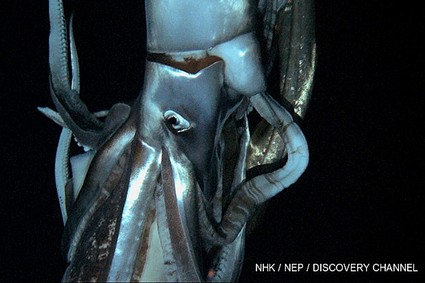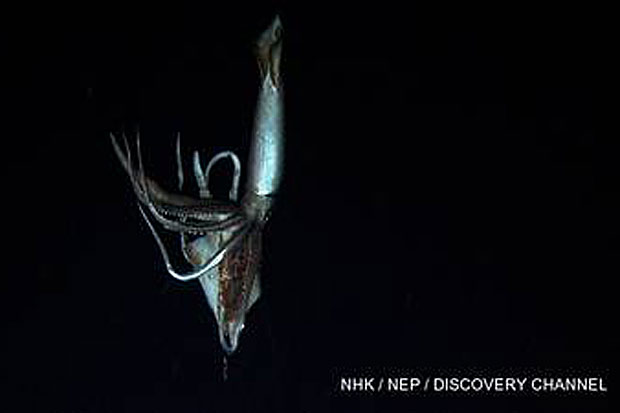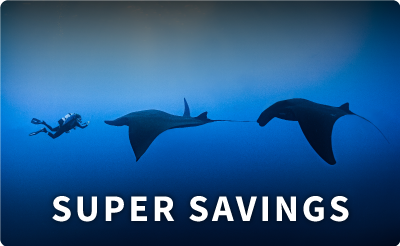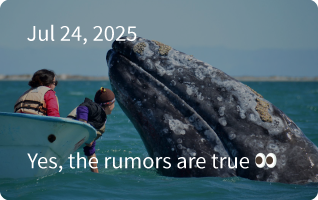New discover shows creature that can grow to be over 40 feet long with eyes the size of dinner plates.

A still image of the giant squid while being captured on video in its natural habitat for the first time.
Once the stuff of fisherman legend, a group of Japanese and American researchers have finally recorded footage of the ocean’s most elusive animal: The giant squid
With eyes the size of dinner plates, end-to-end lengths of up to 43 feet, and weighing 600 pounds, the giant squid is one of the ocean’s largest cephalopods. But until now, dead giant squids had only been found in the stomachs of sperm whales, with whom they are believed to have deep-sea battles, in fishermen’s nets, or floating on the ocean surface.
But by using new video technology, researchers from Florida’s Ocean Research & Conservation Association (ORCA), the National Science Museum of Japan, and other expert marine biologists were able to videotape an adult giant squid in its natural habitat, more than 3,000 feet beneath the ocean’s surface.
In previous years, there had been a few breakthroughs in giant squid search: In 2004, Japanese zoologist Tsunemi Kubodera (who also participated on this project) took the first still photos of a giant squid. And in 2006, Kubodera’s team pulled a live giant squid to the surface, where it subsequently died. The newest footage is the most convincing yet: The team was able to capture more than 18 minutes of video and taped the squid on six separate occasions off the coast of Japan.
“There’d been controversy about whether the giant squid was an active predator or whether it just floated around because of its neutral buoyancy,” says Edie Widder, director of ORCA. “Clearly, from what we saw, it’s an active predator. It’s stunning footage.”
Widder says that in its natural habitat, the giant squid looks much different than the dead specimens that have already been studied.
“None of us expected it to look like that—the ones we find dead at the surface are this reddish color,” she says. “This is gold and silver. It looks like it was made of metal.”
Michael Vecchione, a marine biologist with the NOAA’s National Systemics Lab, who specializes in cephalopods and other invertebrates, says the vastness of the ocean is one of a few reasons giant squids have remained elusive.

“Discoveries are difficult to make in a remote environment like this. It’s the largest living space on Earth, but the things in it are pretty spread out,” he says. Squid are also notoriously shy, and will bolt if exposed to unnatural light.
Widder developed a submersible vessel and video camera that use red lights, which many sea creatures—including giant squid—can’t see. They then used optical lures that mimic deep-sea creatures’ bioluminescent lights to rein in the squid. On one of the dives, the vessel was able to turn on a white light and the squid didn’t flee, allowing scientists to observe the creature for more than 18 minutes.
“The reason we succeeded where others have failed is because we paid attention to the visual system of the squid. It has the largest eye of any animal on Earth, it’s a visual predator,” she says. “Before, I went down in submersibles and shined a light only to wonder how many animals were outside the range of my light—that could see me, but I couldn’t see them.”
Vecchione says discoveries like this are imperative to learning more about marine life’s behavior and should serve as a reminder that only a limited amount of information can be gleaned from dead specimens.
“We’ve got to be careful about the guesses we make on things like preserved specimens. We do the best to infer what’s going on based on the info we have, but a lot of the times we’re wrong,” he says. “The idea that is just passively floats along and waits for something to bump into it proved to be wrong. Getting a new source of information like this is incredibly valuable.”
Just don’t expect to be eating giant squid calamari: Widder says its body contains too much ammonia to be edible.
– By Jason Koebler | www.usnews.com
Original article: http://www.usnews.com/news/articles/2013/01/09/remarkable-new-giant-squid-footage-surprises-experts








